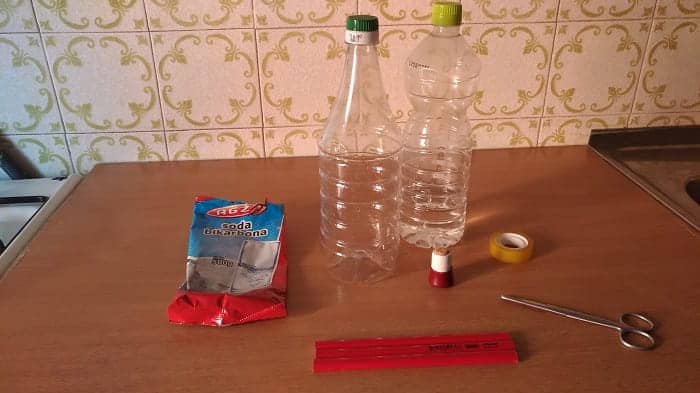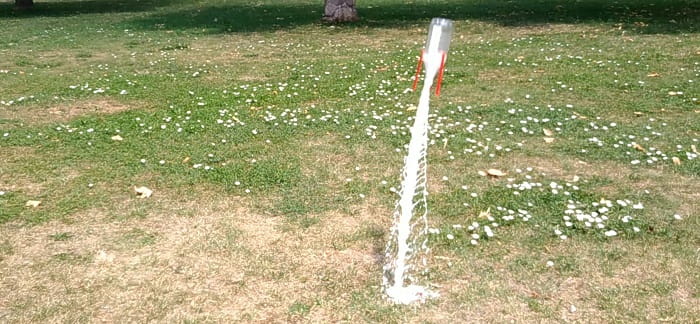Space…The final frontier. Our mission is to boldly go where no rocket on vinegar and baking soda has ever gone before!
Article Contents
1. The science behind rockets2. How does the Vinegar and Baking Soda Rocket work?
3. Materials needed for Homemade Rocket
4. Instructions for Vinegar and Baking Soda Rocket
5. What will you develop and learn
“Status Number One?”
Jean-Luc Picard
“All systems ready to launch captain.”
“Engage!”
What better way to start today’s activity than with the familiar dialog between captain Picard and his first officer from the popular TV show Star Trek? Because today we will show you how to make a homemade rocket and launch it on its very first exploration mission! All we need for our propulsion system is a little vinegar and baking soda. This is an excellent science fair project or school project that will impress everyone and showcase your engineering and science skills.
The science behind rockets
In the distant past, launching a rocket device was largely a matter of chance. It may fly, it may explode or it may fizzle. All advancements in that field were made on a lengthy process of trial and error.
That all changed when humans started to use scientific and mathematical principles of motion. That started in 17. century with great scientists like Galileo Galilei and Isaac Newton. Galileo discovered that moving objects don’t need the continuous application of force to continue moving if there is an absence of friction and drag (in a vacuum). Galileo discovered the principle of inertia that says that all things resist changes in motion. The more mass the object has, the more resistance it makes. Isac Newton advanced Galileo’s discoveries and he made 3 basic laws of motion that are the foundation of all rocket science.
- First Newton law: Objects at rest remain at rest and objects in motion remain in motion in a straight line unless acted upon by an unbalanced force.
- First Newton law: Objects at rest remain at rest and objects in motion remain in motion in a straight line unless acted upon by an unbalanced force.
- Third Newton Law: For every action, there is an equal and opposite reaction.
So the First Newton law tells us how rocket, resting on the launch pad needs the exertion of an unbalanced force to make it move. The amount of that force (produced by rocket engines) needs to be greater than gravity that is holding the rocket. As long as that force continues to work, the rocket will fly up. If the engines stop to produce the force, the rocket will start to fall, pulled by the Earth’s gravity. One important implication in rocket science is that the atmospheric drag (also called friction) is eliminated when the rocket reaches the space. So the rocket flying 11.186 km/s, or 40 270 km/h will manage to leave Earth’s gravity without any additional force used. The rocket will slow down, but never enough that gravity pulls it down and the rocket starts to fall back on Earth.
If you’re interested in exploring First Newton’s law in more detail, be sure to check What is Inertia and how to demonstrate it article where we explore inertia in more details.
Now we need to jump to Newton’s third law to better explain what happens next. The law of action and reaction. When talking about the rocket, gas, smoke and flames that are produced by rocket engines represent action and the rocket moving upwards is a reaction. So even if combustion products from the rocket engine accelerate rapidly, the rocket accelerates slowly. How is that possible if we know that action and reaction should be equal?
The reason is that the mass of combustion products (smoke, fire, gas) is much lower than the mass of the rocket so even if the force is equal, the effect is different. This is explained by the first Newton’s law that states that it takes a force to change the motion of an object. The bigger the mass of an object, the more force we need to move it.
We can see that from the equation stated in the second Newton’s law: f = ma. The force produced by the rocket engine is proportional to the mass that is produced by the burning rocket propellant times the acceleration of that burning rocket propellant. It is important to note that the law only applies to particles going out of the rocket engines and not to the fuel stored for later.
So in short, rocket science says: the more propellant (m) you discharge at the same time, and the bigger the acceleration (a) of that propellant, the greater the thrust (f).
Although knowing Newton’s laws is the first step in building and launching the rocket, there are more factors that influence will our rocket reach the space. One example is air pressure. Air pressure is an important factor while the rocket is still in the atmosphere. The pressure produced by the burning rocket fuel must be greater than the outside air pressure. That means that some fuel needs to be burned just to create enough pressure to compensate for the air pressure. And as the rocket climbs higher and higher, the air pressure becomes smaller so the rocket engine thrust increases.
Another important factor is mass. The mass of the rocket decreases as the fuel is burned, so the acceleration of the rocket increases.
And the last factor we will mention, that can influence the flight of the rocket is the choice of fuel or propellant. Not all fuels are alike, and we would think that the go-to fuel would be the one with higher thrust. But it’s not that simple since every fuel comes with a tradeoff. For example, liquid hydrogen and liquid oxygen produce greater thrust but they both need to be kept at very low temperatures. Next to that, their mass is low and the rocket needs very big tanks to store enough fuel to get the rocket out of the atmosphere.
To sum it up, we can say that knowing Newton’s laws is enough to become a junior rocket scientist but we will need a bit more knowledge to build our first successful rocket. If you are interested in the history of rockets, NASA has some great resources and you can check how did rocket science develop from ancient times until today.
How does the Vinegar and Baking Soda Rocket work?
When we mix vinegar (HCH3COO) and baking soda (NaHCO3), we get the so-called acid-base reaction. Here vinegar is an acid and baking soda is a base. An acid is a chemical that wants to get rid of a positively charged hydrogen atom (proton) and base wants that proton. In that reaction when the baking soda receives proton from the acid, it transforms into water and carbon dioxide. Carbon dioxide rapidly expands, and if the space is too small, it explodes.
While building a rocket, our goal is to allow that pressure to release at the right time and on the right spot. That will make our rocket defy gravity and launch upwards.
Materials needed for Homemade Rocket

- Empty plastic bottle
- Vinegar
- Baking soda
- Cork
- Wooden sticks or pencils (for launching pad)
- Scotch tape
- Scissors
- Optional: Funnel
Instructions for Vinegar and Baking Soda Rocket
We have a video on how to make a homemade rocket at the start of the article or continue reading instructions below if you prefer step by step text guide.
- Make launching pad out of wooden sticks or pencils. Tape 3 sticks so the bottle can stand on them. Tape the sticks so they are going over the bottle cap. When we put a bottle on the sticks, the bottom of the bottle will look upwards, and the bottle cap will look down.
- Check if your cork is a good fit for the bottle. If it’s not, you can use duct tape to make it fit better.
- Decorate bott…rocket as you wish and you are ready to launch!
- It would be really smart to go outside for this. 🙂
- Pour vinegar (1 – 2 dL is enough)
- Using a funnel, pour baking soda in the bottle (1 – 2 spoons). Close the bottle with the cork and turn it over so it stands on the launching pad.
- If the pressure builds too fast, you can put baking soda in a piece of paper, put in the bottle, put the cork on and shake it so you start a reaction
- 3, 2, 1, Blastoff!
What will you develop and learn
- Engineering skills while building a rocket
- Aerodynamics
- Chemical reactions
- Fine motor skills
- Newton’s laws of motion
- That science is fun! 🙂
If you liked this activity and are interested in more ways to build a rocket, check out the article on How to build a match head rocket. And if you are interested in more activities with vinegar and baking soda, try watching How to make a homemade Volcano.
If you’re searching for some great STEM Activities for Kids and Child development tips, you’re in the right place! Check the Categories below to find the right activity for you.

STEM Science
Videos, guides and explanations about STEM Science in a step-by-step way with materials you probably already have at your home. Find new Science ideas.
Read more
STEM Technology
Videos, guides and explanations about STEM Technology in a step-by-step way with materials you probably already have at your home. Find new Technology ideas.
Read more
STEM Engineering
Videos, guides and explanations about STEM Engineering in a step-by-step way with materials you probably already have at your home. New Engineering ideas!
Read more
STEM Math
Videos, guides and explanations about STEM Math in a step-by-step way with materials you probably already have at your home. Find new Mathematics ideas.
Read more
Psychology
Find out all about development psychology topics that you always wanted to know. Here are articles from child psychology and development psychology overall.
Read more
First year of Child’s Life
Following a Child’s development every month from its birth. Personal experiences and tips on how to cope with challenges that you will face in parenting.
Read more


3 thoughts on “How to make Homemade Rocket with Vinegar and Baking Soda”